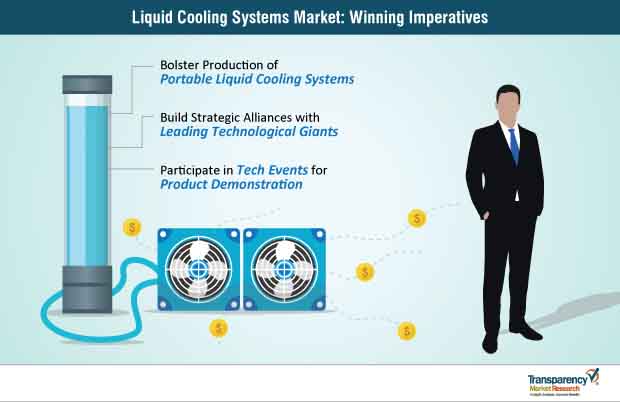
Liquid Cooling Systems Market: High Demand from Data Centers to Transcend Growth
‘Cool liquid media’ is the foremost requirement for all industrial processes. Numerous industrial verticals such as food and beverages, healthcare, data centers, and telecommunications demand the control of liquid media within a defined temperature range for industrial operations. Moreover, there is a rising number of thermal management concerns in engineering applications such as nuclear reactors, industrial heat exchangers, micro machinery, and others. Liquid cooling systems have a pivotal role to play in achieving thermal management in dramatically high system power levels.
The proliferation of technologies such as the Internet of Things (IoT) and Artificial Intelligence (AI) create aggressive cooling requirements, thereby shifting consumer demand from conventional to advanced cooling systems offering better thermal performance. Moreover, product innovations spawned in the landscape of liquid cooling systems have further added a feather in the cap for the liquid cooling systems market, creating the need for in-depth research. In its latest study, Transparency Market Research offers credible insights on the key dynamics of the liquid cooling market, which help stakeholders take well-informed and data-driven business decisions.
Planning to lay down future strategy? Perfect your plan with our report brochure here https://www.transparencymarketresearch.com/sample/sample.php?flag=B&rep_id=69588

Evolutionary Landscape of the Liquid Cooling Systems Market
Liquid cooling technology is not a new sheep in the market; it has been used since decades to cool high-voltage transformers. Traditionally, liquid cooling systems were majorly used for supercomputers and mainframes. However, they have now seeped into enterprise data centers. They first grabbed the limelight back in 1964 when IBM explored immersion cooling for its System 360 mainframe. Ever since, the technology has evolved from being a ‘fringe concept’ to becoming a ‘must-have’ for numerous industries.
Air-based cooling systems no more suffice the cooling needs of new generation enterprise data centers with high power density. With the rise in consumer preference for liquid cooling, it is gradually becoming mainstream in the arena of data centers. According to TMR, the liquid cooling systems market is poised to rise at an astounding CAGR of ~ 13% during the forecast period of 2019 to 2027, and attain a valuation of ~ US$ 6.4 Bn by 2027. However, the high cost of liquid cooling systems still remains a longstanding challenge for the growth of the market.
Trends Redefining the Liquid Cooling Systems Landscape
Smartphones with Liquid Cooling Systems to Fetch Revenue Benefits
Smartphone manufacturers are going all out to turn smartphones into mini computers that fit in pocket. Smartphones are getting slimmer, but with in-built high-end processors generating massive amount of heat. Moreover, smartphones designed for gaming need advanced processors, creating the challenge of keeping the hardware cool. Sensing the high demand for smartphones and the need for thermal management, phone makers are increasingly integrating liquid cooling solutions in smartphones. For instance, Samsung developed a method of liquid cooling for the Galaxy S7 phone, which uses a copper thermal pipe to disperse heat away from the CPU. Further, in April 2019, Nubia Technology announced the launch of a gaming phone called Red Magic 2 with a liquid cooling function.
Rise in Deployment of Portable Liquid Cooling Systems
Data centers need to maintain the required thermal balance, as equipment is prone to damage due to heating issues. Although data centers are using permanent cooling units, there is always the need for maintenance. In such a scenario, a portable cooling unit may be necessary for the optimal functioning of a data center until a permanent cooling unit is up and running. Portable liquid cooling systems are increasingly taking center stage as the primary cooling systems for in-building server rooms and industries in areas with mild temperatures. They are also a cheaper alternative to permanent data center cooling units.
Want to know the obstructions to your company’s growth in future? Request a PDF sample here https://www.transparencymarketresearch.com/sample/sample.php?flag=S&rep_id=69588
Liquid Cooling Systems Market: Key Winning Strategies
Strategic collaborations is one of the key winning strategies deployed by prominent enterprises in the liquid cooling systems market. Due to the presence of a large number of players in the market, there is a high possibility of substitution, as consumers have a large pool of service providers to choose from. In a bid to maintain a loyal consumer base, companies are establishing strategic alliances with technological giants, data centers, healthcare industries, and others to provide customizable solutions for their products. For instance, in March 2019, Boston Limited, a company that manufactures storage devices, servers, and similar products announced a partnership with Asperitas, a liquid cooling systems provider. According to this partnership, Asperitas will be providing liquid cooling solutions for Boston Limited’s products.
Another overarching strategy that has helped players expand their footprints in the liquid cooling systems market is the inclusion of novel cooling products in their portfolio. New-age data centers demand highly advanced cooling solutions that are reliable and offer impeccable consistency. Sensing this demand, companies are laying considerable emphasis on product innovation. For example, in January 2019, CoolIT Systems, Inc. launched a novel liquid cooling solution made for the Intel Server System S9200WK. Similarly, Asetek, Inc. collaborated with Intel Corporation to develop a novel all-in-one liquid cooler called Asetek 690LX-PN for gaming and data center applications.
Product Innovation to Drive Competition
The liquid cooling systems market features a moderately competitive vendor landscape, characterized by the presence of a large number of component suppliers, manufacturers, and distributors. Key companies functioning in the market include Laird Thermal Systems, Boyd Corporation, Lytron Inc., Rittal GmbH & Co. KG, and Asetek, Inc., among others. The competition in the market is mainly driven by product innovation, as players are strengthening their technological bases through collaborations and partnerships.
Established players are making a mark in the market through the expansion of their geographical presence, and also sizeable investments in research and development activities. Players are also participating in conferences and tech events for product demonstration, and creating a global presence. For instance, Allied Control Ltd. recently participated in the Supercomputing Conference to exhibit a two-phase immersion cooling system. Providing instant customized quotations is another differentiating strategy deployed by key players. This helps customers take quick decisions about product purchasing through quick pricing estimation. Further, building a robust distribution network also remains a key focus area for partakers.





